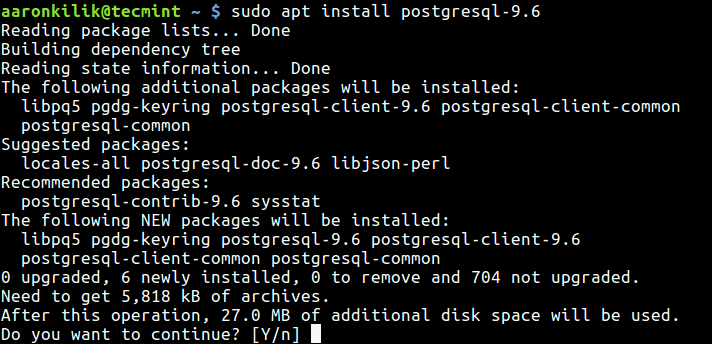
#Postgresql install install
PostgreSQL 11 and Postgresql 11 libs are dependency packages to install the PostgreSQL DB server.Īfter installation, we need to initialize steps to create a new database cluster of the PostgreSQL database.For installing this, we need to install the below package as follows.Also, we need to install the PostgreSQL libs package for resolving dependency to install the PostgreSQL DB server.We need to install the PostgreSQL client and PostgreSQL server to install the PostgreSQL database.Install PostgreSQL on CentOS by using the following command. It will show all the PostgreSQL desired versions. Then we list all packages and versions by using the following command. Then we need to install the repository configuration package by using the official PostgreSQL repository for CentOS.Īfter executing the above command, the process will prompt, then we confirm the installation by pressing key “Y”. Gpgkey = file:///etc/pki/rpm-gpg/RPM-GPG-KEY-CentOS-7 Then we need to insert “Exclude = PostgreSQL* in both sections after saving the file using ESC + “wq”.The file finds the base and updates section in the repository and inserts it by pressing “i” after opening and repository file.Then open the repository file using vi or vim we have using vi to edit the below file.We need to exclude the search of PostgreSQL from the repository for installing it from the base repository. We have using the CentOS base repository to install PostgreSQL on CentOS.We have using CentOS version 7.7 to install PostgreSQL.īelow is the command to check the CentOS version:Įdit CentOS base repo (Repository file) to install PostgreSQL DB. Let us discuss the procedure to install PostgreSQL in detail.
#Postgresql install download
We need to have download PostgreSQL RPM packages from PostgreSQL’s official website. See issues attached to the PostgreSQL tag.9. You may find the /var/log/postgresql/ file to be useful. On a remote machine it should be possible to set up Gramps with the IP address or hostname of the PostgreSQL server and the port number (default value is 5432). Here we can see that “Local Address” for port 5432 has changed to 0.0.0.0. On my Ubuntu it was located at /etc/postgresql/9.5/main/pg_hba.confĪnd use netstat to see if we are set up for remote access. In order to fix it, open pg_hba.conf and add following entry at the very end. The system also is configured to limit remote logons for specific user(s). On my Ubuntu it was located at /etc/postgresql/9.5/main/nf In order to fix this issue we need to find nf.

We can try hitting the port 5432 by using telnet. It means any attempt to connect to the postgresql server from outside the machine will be refused. Proto Recv-Q Send-Q Local Address Foreign Address StateĪs we can see above port 5432 is bound to 127.0.0.1. We have to make a few changes on the remote server to allow remote access. Remote Server: Configure PostgreSQL to allow remote connectionīy default PostgreSQL is configured to be bound to “localhost”.

When you try to load a family tree, you be be shown the Login dialog where you can enter the user name and password, these are the same values used in the createuser command above.Īt this point, you should be able to use Gramps normally. PostgreSQL addon - login - dialog - example You can name it "Family Tree 1" or whatever you want. Answer "n" to superuser and "y" to the other questions.Ĭreate a new database for your family tree. PostgreSQL will prompt you with several questions. Within the "postgres" account, create a user from the command line with the createuser command. Use the sudo command to switch to the new "postgres" account. However, we need to create a user and a database instance to really start using it. We now have PostgreSQL installed and the PostgreSQL service is running in the background. Sudo apt install libpq-dev python3-dev python3-pip Or if that does not work install from you can install from pip using: Which fully implements the Python DB API 2.0 specifications.) on Ubuntu either using:

Then install Psycopg (the PostgreSQL adapter for the Python programming language. Sudo apt-get install postgresql libpq-dev postgresql-client postgresql-client-common Note these instruction assume you are using Linux or development environment.Īs the Gramps AIO & MacOS installers do not come with the Prerequisites and can not be installed easily.


 0 kommentar(er)
0 kommentar(er)
